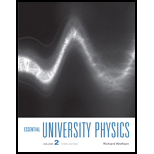Solutions for Essential University Physics: Volume 2 (3rd Edition)
Browse All Chapters of This Textbook
Book Details
Just the Essentials
Richard Wolfson’s Essential University Physics, Third Edition is a concise and progressive calculus-based physics textbook that offers clear writing, great problems, and relevant real-life applications in an affordable and streamlined text. Essential University Physics teaches sound problem-solving skills, emphasizes conceptual understanding, and makes connections to the real world. Features such as annotated figures and step-by-step problem-solving strategies help students master concepts and solve problems with confidence.
Essential University Physics is offered as two paperback volumes available together or for sale individually.
Also available with MasteringPhysics
MasteringPhysics from Pearson is the leading online homework, tutorial, and assessment system, designed to improve results by engaging students before, during, and after class with powerful content. Instructors ensure students arrive ready to learn by assigning educationally effective content before class, and encourage critical thinking and retention with in-class resources such as Learning Catalytics. Students can further master concepts after class through assignments that provide hints and answer-specific feedback. The Mastering gradebook records scores for all automatically graded assignments in one place, while diagnostic tools give instructors access to rich data to assess student understanding and misconceptions.
Mastering brings learning full circle by continuously adapting to each student and making learning more personal than ever–before, during, and after class.
Sample Solutions for this Textbook
We offer sample solutions for Essential University Physics: Volume 2 (3rd Edition) homework problems. See examples below:
More Editions of This Book
Corresponding editions of this textbook are also available below:
